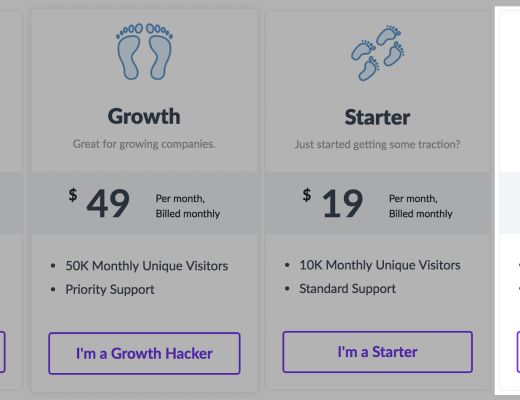Regardless of your marketing approach, developing high quality leads requires a meaningful investment in either time, or money.
If you don’t already know, take a moment to figure out your average cost per lead. If you are paying for ads take your monthly spend and divide it by the number of leads you receive.
And if your expenses are mostly related to effort (ie content marketing or cold email) then figure out how much you spend on labour.
It’s a lot, isn’t it!
When you realize how much you are spending to generate new opportunities, closing them gains urgency. After all, you don’t want that investment to go to waste!
Here are four ways you can increase your sales closing ratio and maximize value from your marketing spend.
Bring Your Outcome To Life
In marketing, the best websites convert visitors to leads by helping them experience the outcome they can expect to achieve.
And what’s true in marketing also works in sales. The better your prospect experiences your solution in a visceral way, the more likely they are to take action.
When you visit a car dealership, the sales agent doesn’t say, “let’s look at a powerpoint presentation of this model’s engine features.” They want you to sit in the car to inhale that new car smell. If you’re a serious buyer then they’ll suggest a test drive. They want you to feel a connection to the vehicle before they suggest a close.
While not as easy, the same principles hold true for consulting and intangible solutions. The more you can make a desired outcome feel real, the easier it will be for the prospect to agree to become a client.
Keep Adding Value
Imagine a conversation where all you have to contribute is “just checking in.”
Pretty boring right!?
It’s a good bet your prospect is going to eventually stop responding if you contact them with nothing of substance.
Map out at least 10 ways you can add value to your prospect after you’ve had an initial discussion. Who will they need to speak with next? Do you have any collateral that would make that conversation easier? Do they need your help to share things with their boss?
One way to add value is to start working on their project as though they had already agreed to start. No other providers are going to show that much sincere interest in their business. And prospects will fall in love with your commitment to their outcomes.
Maybe that sounds crazy, but there’s no better way to demonstrate value. As you work on their project, questions will arise naturally and you’ll have strong reasons to keep in contact.
Another way to add value is to prepare content that you know will be of use in their situation. Create multiple types of content and drip it out over weeks or months. Try to be as helpful and varied as possible. Also, look for ways to interact via phone or in person. Content is wonderful, but human connections are critical.
Align Your Timing
I’ve got some bad news… Your prospect doesn’t care that it’s the end of the quarter and you have a quota.
Prospects buy according to their schedule. And your sense of urgency doesn’t factor into their decision making. In fact, it probably annoys some a lot of buyers.
To be effective, adopt the pacing of your prospects. Some are ready to buy today, but others won’t be ready for weeks or months.
Matching your prospect’s timing isn’t easy. Start by finding out what steps they’ll need to conduct to get the deal approved. And you can ask for a timeline for how long it will take to complete each step.
The nice thing about clarifying your prospect’s timing is that it will highlight areas where the deal could potentially derail. For example, if the prospect needs approval from other stakeholders then you’ll want to participate in those conversations.
They say ‘timing is everything’ and that’s never more true than in sales. The better you match the cadence of your prospect, the more likely you are to see a successful conclusion.
Don’t Take ‘Yes’ For An Answer
Sales training prepares us to effectively overcome sales objections. We’re told in no uncertain terms, “don’t take no for an answer.”
But think back to your last ten sales presentations. How many people gave you a hard ‘no’? Perhaps we should put more focus on the prospects who give a cheerful “yes,” instead.
Prospects usually appreciate the insights you’ve provided. And they’re grateful for the time you’ve invested in their success. So when you ask for their degree of interest it’s a lot easier for them to say “sounds good” than it is to tell you they probably won’t be buying.
Once the meeting is over, you may not have a chance to directly connect with them again. With this in mind, treat your positive responses with a bit of skepticism. In other words, don’t let their sugar coated words go unchallenged.
One approach is to ask them to affirm why they like your solution. When they share what elements most appealed to them, you can follow up with a question about timing and delivery.
You may find at this point they ‘remember’ other decision makers that need to be consulted before a deal can be finalized. These sorts of red flags mean that they aren’t as engaged as they originally appeared. And it would be worthwhile to revisit any areas of concern.
This exercise is especially effective to understand how your solution is really perceived by your prospects. If nine out of ten opportunities tell you they are concerned about the same thing, then it’s worth trying to improve in that area.
Done Deal
The four tips above share a common theme. They all require thinking about things from the prospect’s point of view.
Consider what they want to accomplish and make that outcome more certain for them. The more they feel like you can help them solve their problem, the more likely they are to work with you.
While waiting for a deal to go through, keep adding value to the process. Your prospect is probably speaking with other companies. So make it clear you are the best option for their business.
Align your communications with their timing. If they expect the closing process to take 12 weeks then plan accordingly.
And finally, don’t take positive feedback at face value. There’s a lot that can go wrong before the deal closes. Take the time to explore future obstacles while you still have an enthusiastic prospect in front of you.
In sales a little empathy goes a long way. When you act in accordance with your prospect’s circumstances your closing ratio will increase exponentially.







